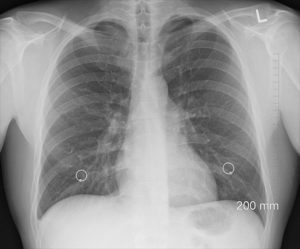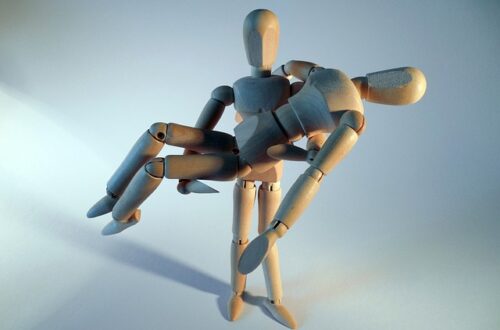
The art of distinction – three dimensions in one breath
A holistic view of the breath requires ideas that go beyond the purely physical approach
– written by Christine Richter –
Normally the breathing process is understood as a purely physical process. From a scientific point of view, it is a muscularly caused expansion of the lungs, which like a kind of pump sucks air into the body and then releases it again by relaxing the muscles. The lung is filled with oxygenated air by the process automatically controlled by the vegetative nervous system, so that the necessary gas exchange between blood and breathing air takes place in the pulmonary alveoli. It seems to be a purely physical process that takes place continuously, even at night when consciousness is absent.

We might ask ourselves what sensations are generated by such an idea. How does it feel when we think of the lung as a mechanical suction pump?
Through a freedom, which is only accessible to humans, it is possible to intervene in this process deliberately, to change it in many ways, for example by taking a slow deep breath and leading the flow of breath, up to the abdomen, into the flanks and finally also into the tips of the lungs, in order to use the full breathing volume. Exhalation can also be intensified and slowed down. The usual idea, from which we experience and understand the whole process, is a purely material one. Well-being increases because we take in more oxygen, thinking becomes clearer because the brain cells are better supplied with just this elixir of life. All cells and organs benefit from it. Health, we know, is promoted all around by such an approach.
Physically seen the breath serves the gas exchange. It receives its optimum at the best possible oxygen supply and carbon dioxide disposal of the body. But what would be, if we would include a soul-, maybe even a spiritual level in the consideration?
In the method of “Experiential Breath” (1), for example, founded by Ilse Middendorf, the focus of interest is on consciousness and the way of experiencing. When the soul level is added, the relationship of a relationship in itself takes on a significance that transcends the material level. We could put it that way: The soul dimension comes into play with the conscious perception of something, such as breath. It would therefore be characterized above all by a consciously made relationship with an object. The astonishing thing on the soul level seems to be, among other things, that by consciously and concretely perceiving an object, we also become aware of ourselves as observers. The “I” and what we perceive are distinguished. This seems to be normal, an everyday occurrence, but it becomes interesting as soon as we choose our own body as the object of observation.
In the relaxation exercise of yoga, for example, this is possible. The body rests motionless on the ground, but the consciousness, with its freely moving perception, is active and observing. The practitioner naturally differentiates himself from the body by noticing himself in being active. However, the “action” is not a physical one in the conventional sense, but a purely mental one. The consciousness is active. In order for this awareness to occur, no suggestions should be used during relaxation, but the real state, as imperfect as it is at the moment, should be perceived. Emotional reactions that emerge from the subjective inner being should not gain the upper hand either, as they have the irresistible tendency to take over the space and, like a shell, to cover everything that is objectively present.
Whether what I perceive triggers sympathy or antipathy in myself, i.e. my emotional reaction, is considered unimportant for the moment, so that a greater clarity and freer position can be achieved in relation to the actual thing (in the relaxation exercise this would be, for example, the body or the movement of the breath). In this way, the practitioner also observes his own emotions.
It is interesting to note that tensions usually begin to release immediately as soon as the light of perception falls on them. Unconsciously we had held on to something that had expressed itself on the physical level in form of a tension. Practiced in this way, the relaxation exercise leads to a relationship and sensitive closeness to one’s own body, which is, however, distinguished from the “I”, the observer. The body becomes an object in the experience.
This process can be called a soul experience. Through perception, the soul connects the “I” (the spirit) with the material world. The practice of a differentiated perception free of projections would therefore lead to the development of a consciousness about the trinity of spirit (I, subject), soul (light, or consciousness as an instrument of perception) and body (manifested world, objects of perception). Without this discriminating ability, we remain trapped in the material world of imagination with its subjective feelings.
Our thoughts and ideas play a crucial role in the cognitive experience. They are like a key that opens the door to the soul level with its calming and liberating perception. Such a thought, which lifts the consciousness out of its material constriction, must also carry a knowledge of the invisible dimensions beyond the material plane. The following quotation from the book “Yoga and Christianity” by Heinz Grill should serve as an example for a “holistic” thought that unites all three levels of reality within itself and can thus open the closed door:
“It is not the earthly world that breathes in the cells, but the supernatural or spiritual world. It is finer than the finest, lighter than the lightest, wider than the widest.” (2)
Let this thought take effect on you for a moment. How does such an expanded idea affect your feelings? To be able to empathise with the thought, we could visualise what a body cell represents. It is so small that it cannot be seen with the unaided eye.A book on biology could help us to get a real impression of its basic structure. This is almost the same for all living organisms, be they primitive unicellular organisms, highly developed animals, humans or even plants. Although plants have additional green chloroplasts in their cell plasma because they carry out photosynthesis and have more stable cell walls, they are otherwise constructed in the same way as the cells of all other living organisms. The cell is therefore a kind of universal phenomenon of living things.
All cells, whether they are unicellular organisms or complex organisms, “breathe”. In science we speak of internal or cellular respiration. This takes place in cell organelles, the so-called mitochondria.The fact that this inner life in the cells is not only a biochemical, i.e. material life, but that “the supersensible or spiritual world in it breathes” can perhaps not immediately be understood with the intellect, but on the feeling level. With the breath we touch the phenomenon “life” par excellence – which is called “mystery” and therefore can never be satisfactorily explained from the purely material level.
Out of respect for this scientifically not easily comprehensible “depth” or even “size” of the living breath, Ilse Middendorf’s “Experiential Breath” does not intentionally grasp and manipulate the breathing process, but rather gets to know it by observation. With the help of consciousness, the human being gets to know the breath and thus himself in a distinctive way. He or she experiences where it comes from and where it goes, in which “spaces” it moves, and how it reacts to certain sounds, gestures and movements. In all these efforts, the breath appears as an independent living counterpart. The observation becomes a “contact” with something that, according to Ilse Middendorf, can even give the individual orientation in life. In an interview published in 1990 in the unfortunately no longer existing magazine “Pierrot”, she speaks about the “Guide Breath”. Furthermore, she describes in her breath theory the possibility of conducting a “breath conversation”, which is expressed in sensitive, very aesthetic, as well as weightlessly flowing hand and arm movements. It is interesting to see how the approach presented by Ilse Middendorf, which is expanded to include soul aspects, shows completely different values than a purely material approach. In the interview, for example, she speaks enthusiastically about getting old. She had just turned 80 at the time and said: “I think that breath helps you to like getting older because you don’t get less. The physical strength becomes a little less, but the life force as such increases. The soul life becomes stronger and more extensive and the spiritual life also. I still feel me in full process of unfolding .” (1)

Besides the developed plane of encounter and relationship in the breath, there seems to be another possibility regarding the experience with breathing. For example, we could ask ourselves what effects mental images have on the experience of breathing. I can think the breath “wide”, in connection with the boundless airspace surrounding me, or “narrow”, i.e. purely physical, related to the body. Depending on the nature of the ideas, consciousness can be limited to the physical body, identify itself completely with it, or expand beyond the physical boundaries into cosmic expanses. The latter state is generally experienced as relaxed, light and free. In the former, the gravity of the body enters more into the experience, and the breath also feels more material, i.e. less connected to the vastness of open space. These different sensations of one and the same breath can be experienced in a simple way with an exercise:
While standing, with the upper body relaxed, move both arms sideways upwards with a slow, wide movement until the hands touch above the head. Then the arms also return slowly and weightlessly to their starting position. The whole process can be repeated rhythmically several times.
This simple exercise can be performed in two ways:
A You combine the calm raising and lowering of the arms with inhalation and exhalation in such a way that the lungs fill up as completely as possible to the tips of the lungs when raised and empty themselves again just as completely when lowered. Doing this the will is used and the breath is consciously grasped.
B Attention is now less focused on the body, on grasping and guiding the flow of breath, and on filling the lungs completely with air, but is directed to the outside, to the immediate surroundings, to the elegant movement of the arms as well as to the flanks that are involved in the movement. With the sense of touch, the air element is sensitively perceived and the atmosphere surrounding the body is felt. Otherwise it is the same exercise, only the mental orientation is different. Even here the inhalation and exhalation may be combined with the raising and lowering of the arms, but in contrast to the first exercise this is not forced.
The difference of breathing quality is subtle but still significant. It can be noticed immediately. Depending on how the attention is directed, we experience the breath either more physically or more body-free, in connection with the air in the open space. The first, more vital form, charges the body energetically. The second type, on the other hand, brings a lighter sensation, relaxation and a feeling of calm, while in the first type, due to the invigorating vitalization, a subtle restlessness can also be felt. This arises, among other things, through the stronger identification of consciousness with the body.
In relation to breathing, we could also think of the body as a kind of open vessel that receives the breath coming from outside, instead of mechanically sucking it in like a pump. The breath, experienced as an independent movement, penetrates the body in all its parts down to the last corner, more precisely down to every single cell, in order to leave the body again with the exhalation.
The origin of the perceived movement would not lie in the body, but in the infinite vastness of the outer space, in the “cosmos”. Such an imagination, extended to the environment, would produce a completely different sensation than the material view expressed at the beginning of this article. The breath would be experienced as a free movement that encompasses much larger spaces than previously assumed.
The origin of the perceived movement would not lie in the body, but in the infinite vastness of the outer space, in the “cosmos”. Such an imagination, extended to the environment, would produce a completely different sensation than the material view expressed at the beginning of this article. The breath would be experienced as a free movement that encompasses much larger spaces than previously assumed. Interesting in this context is the experience that limiting the imagination to the physical leads to an increase in anxiety and increased restlessness, while an expansion of consciousness to out-of-body areas can directly contribute to a feeling of calm, lightness and relaxation.
© Christine Richter

(1) Ilse Middendorf (1910-2009) founded a breathing school and a healing method in dealing with the breath, which she called “The Experienced Breath”. In 1984 a book with the same title was published by her in Junfermann-Verlag.
(2) Citation from the book: Yoga und Christentum by Heinz Grill, 4th edition 1998, Verlag für Schriften von Heinz Grill, p.71 (currently only available as antiquarian).
Translated with the help of www.DeepL.com/Translator (free version)




